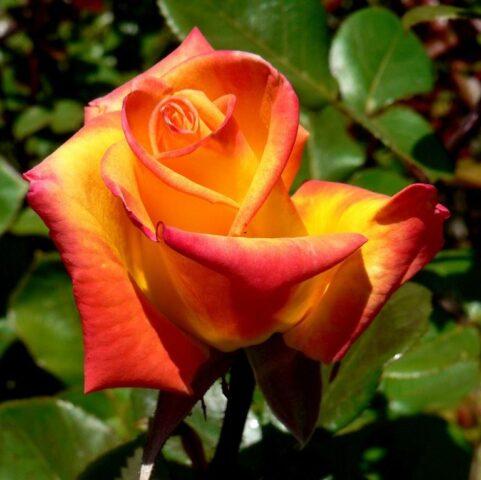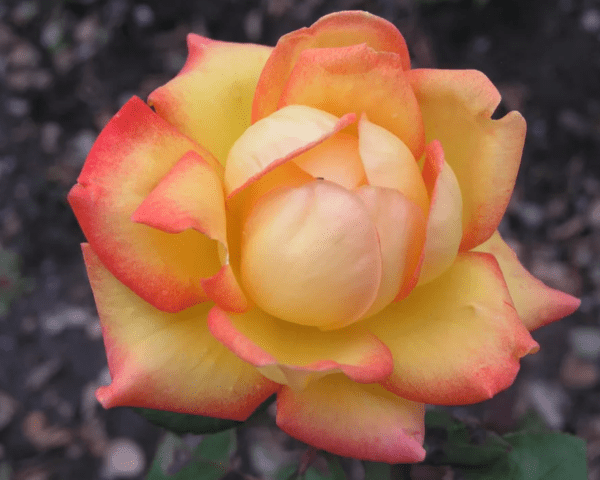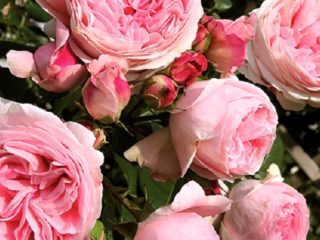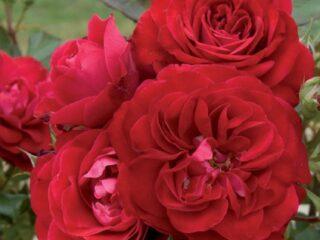Content
- 1 Breeding history
- 2 Description of floribunda Red Gold rose variety and characteristics
- 3 Advantages and disadvantages of the variety
- 4 Reproduction methods
- 5 Planting and caring for a rose Floribunda Red Gold
- 6 Pests and diseases
- 7 Application in landscape design
- 8 Conclusion
- 9 Reviews with a photo of a rose floribunda Red Gold
Rose Red Gold is an attractive flower with an original scarlet and golden color. It blooms 2 times in early and late summer. Inflorescences of medium size, 1-3 pcs. on the peduncle. They have a pleasant lemon balm scent. Well suited for both garden decoration and cutting.
Breeding history
Rose Red Gold (Rose Red Gold) - a variety of English selection, obtained in 1971. Translated from English, the name means "red gold". The petals are painted in rich coral tones with a golden core. The variety spread rather quickly in the UK and neighboring countries. Due to its relatively high winter hardiness, it can be grown in the climatic conditions of Russia.
Description of the floribunda Red Gold rose variety and characteristics
Rose Red Gold belongs to the hybrid tea varieties. The bush is medium-sized, reaches 90–120 cm in height, the crown is dense. Leaves are dark green in color, medium in size, with a shiny surface. Sometimes foliage takes on a reddish tint. Shoots are strong, covered with thorns.
The flowers of the Red Gold rose are of a classic goblet shape, double type (arranged in several rows). On each peduncle there are 1-3 medium-sized buds. The diameter of the inflorescences is 7–8 cm. Repeated flowering: June and August-September. The color is coral, scarlet, watermelon, a golden hue is noticeable in the middle of the petals. Thanks to this contrast, the flowers look very impressive and always attract attention.
The main characteristics of the Red Gold rose variety:
- medium-sized bush (up to 1.2 m);
- medium flowers - 7–8 cm in diameter;
- color: bicolor (scarlet, golden);
- budding period - June and August;
- terry type;
- rain resistance: sufficient, but some specimens are damaged;
- the color does not fade in the sun;
- pleasant lemon balm aroma, weakly expressed;
- winter hardiness: zone 6 (withstands up to -23 degrees without shelter);
- cut stability: high;
- resistance to powdery mildew and black spot: not the highest;
- attitude to lighting: photophilous;
- care: responsive to regular watering and feeding;
- application in garden design: single plantings and compositions.
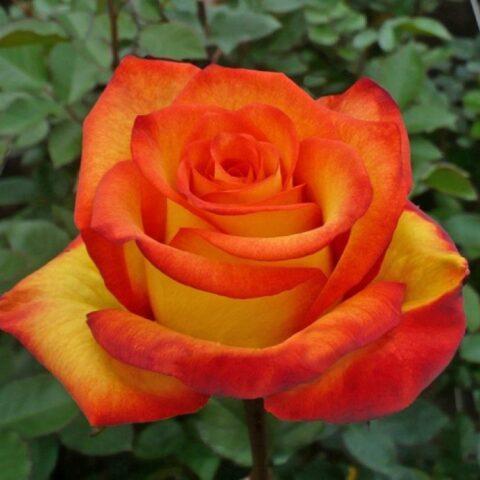
Rose Red Gold belongs to the classic bicolor varieties
Advantages and disadvantages of the variety
The culture attracts with its interesting coloring. On the one hand, the petals are very bright, and on the other hand, the scarlet and golden shades do not irritate the eyes and, moreover, look more original than the classic red ones.
Benefits of the Red Gold rose variety:
- attractive coloration;
- flowers of a classic form;
- re-flowering;
- suitable for cutting;
- do not fade in the sun;
- comparatively resistant to rain;
- the bush is compact, neat, strong shoots;
- have a pleasant aroma;
- can be grown in the middle lane and in the south of Russia;
- there is immunity to major diseases.
There are also some disadvantages:
- in most regions, the culture requires shelter for the winter;
- the bush is covered with thorns.
Reproduction methods
Red Gold rose can be propagated by cuttings. At the beginning of summer, several green shoots 15 cm long are cut, all leaves are removed, and an oblique lower cut is made. Then put for several hours in "Kornevin", "Heteroauxin" or another growth stimulant. After that, they are planted in a greenhouse under a film or a jar in fertile soil - sod land with humus, peat and sand (2: 1: 1: 1). For the winter, watered and covered with foliage.In the spring, they are transplanted to a permanent place, given nitrogen fertilizers and watered.
Another easy way to propagate a Red Gold rose is to get cuttings. In the fall, several grooves are dug around the bush with a depth of 15 cm. The lower shoots are bent and pinned, leaving only the upper part. Watered, covered with foliage, fed with nitrogen fertilizer next spring. In the fall, they are divided into several parts with roots, transplanted to a permanent place, watered and mulched again.
Planting and caring for a rose Floribunda Red Gold
Red Gold rose saplings are purchased from reliable suppliers, they are carefully examined when buying. The shoots and roots must be healthy and the leaves must be clean (without the slightest stains). Planting can be scheduled for both spring (April) and fall (September - October). The place must meet several criteria:
- the soil is fertile, light (loamy or sandy loam);
- away from lowlands, where there is no stagnation of moisture;
- the place is protected from strong winds;
- the site is open, slight shading is allowed in the south.
Tall crops not only create shade, but can also provoke the spread of pests.
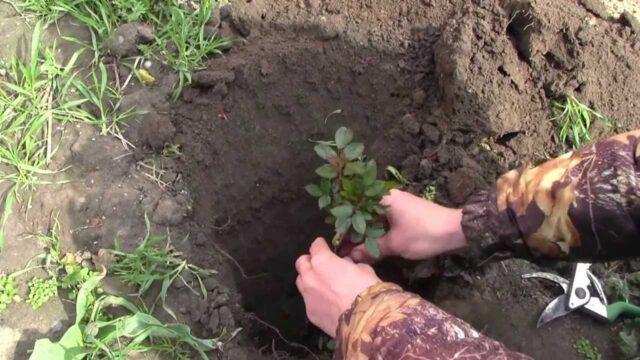
To plant a Red Gold rose, you need to dig a hole 40 cm deep and in diameter
If the soil is depleted, then a few months before planting it must be prepared. The earth is dug up and covered with humus or compost in a bucket per 1 m2. Instead of organic matter, you can apply a complex mineral fertilizer 60–80 g for the same area. Sawdust or sand is necessarily embedded in clay soil, 1 kg per 2 m2.
3-4 weeks before planting, Red Gold roses dig several holes at a distance of 40-50 cm from each other. A drainage layer of small stones is laid in them and fertile soil is covered. During landing, they act in this way:
- The roots of the Red Gold rose are soaked in Kornevin or Epin.
- They are planted in pits.
- Sprinkle with earth so that the grafting site remains slightly above the ground level. In this case, the root collar should go 7–8 cm.
- Water it abundantly, give urea or other nitrogen fertilizer in the spring.
- The earth is slightly tamped, mulched with peat, humus, sawdust.
Rose Red Gold requires some care, but a novice florist can also cope with the task. It is necessary to organize the correct watering. The soil should be moderately moist without stagnation. Under normal conditions, water is given weekly in a bucket per bush (pre-defended at room temperature). In drought, watering is doubled.
Red Gold rose dressing is applied regularly:
- in early April, urea (15–20 g per bush);
- in June, during the formation of buds - superphosphate (40 g) and potassium sulfate (20 g per bush). In August, during the second wave, it is necessary to repeat the same feeding.
Special attention should be paid to pruning. In the first years of life, the Red Gold rose bush grows very actively, therefore, regular pinching of the shoots is required. Flowers last 10-15 days, after which they wither - the peduncles need to be cut off to provide a magnificent second wave of flowering. Every spring (at the end of March), sanitary pruning is carried out, removing damaged and frostbitten branches.
It is important to understand that the Red Gold rose needs winter shelter in all Russian regions, except for the southern ones. When preparing, the bush is well watered, the soil is mulched with peat, foliage, sawdust. The shoots themselves are bent to the ground and covered with burlap or spruce branches. In early spring, the shelter is removed.
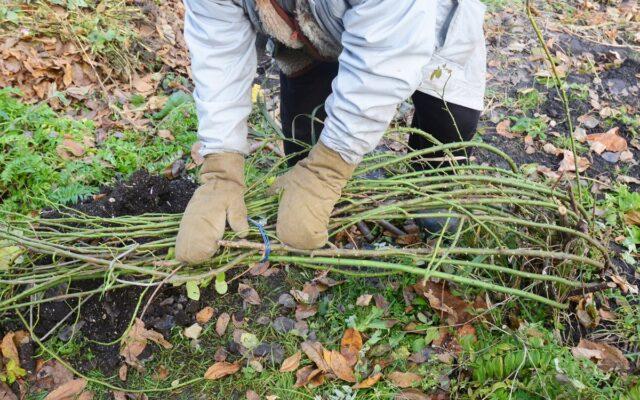
For shelter for the winter, rose shoots can be tied together and pressed to the ground.
Weeding is carried out as needed.
Pests and diseases
Rose Red Gold has satisfactory immunity to powdery mildew and black spot. But in unfavorable seasons, she can suffer from these diseases and other infections. Therefore, every spring it is recommended to carry out preventive treatment with fungicides: Bordeaux liquid, copper sulfate, "Ordan", "Topaz", "Profit", "Tattu", "Fitosporin".
In summer, caterpillars, aphids, scale insects, spider mites, slobbering pennies and other pests are often found on the bushes of the Red Gold rose. You can cope with them with folk remedies. For these purposes, use a solution of ash with laundry soap, infusion of tobacco dust, arrows and cloves of garlic, onion husks, decoction of potato tops and others.
If the invasion is strong, it is necessary to carry out the treatment with insecticides: "Biotlin", "Aktara", "Vertimek", "Fufanon", "Match", "Inta-Vir" and others.
The procedure is carried out in the evening, in dry and calm weather.
Application in landscape design
Red Gold rose bushes are compact, and the flowers themselves are very bright. Therefore, the plant looks beautiful in single plantings on manicured lawns, next to the porch.
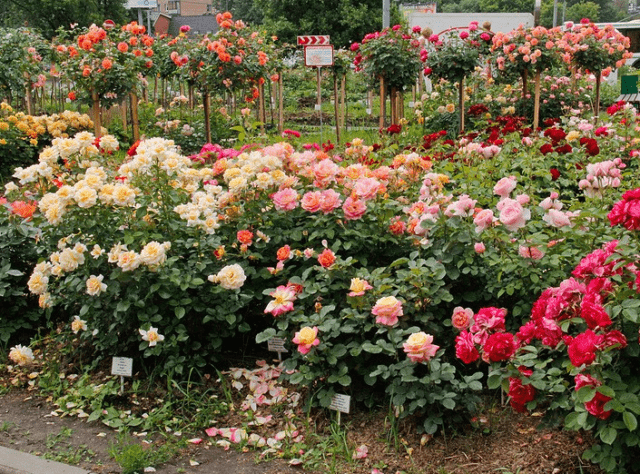
Roses are always great in mass planting
The flower is suitable for any style of garden - English lawn, country, French landscape, classic, modern and others.

Red Gold dummy uniform looks elegant in a single fit
Saplings can be placed along the central road, leaving a distance of at least 1 m between them.

Red Gold rose bushes attract attention in any flower bed
They can be placed in a circle or in a line, this will not make the design worse
Conclusion
Rose Red Gold is an interesting variety that can be grown in the garden. The bushes are compact, grow well, therefore, in the first years of life, you need to take care of formative pruning. Flowers can be used both for garden decoration and in bouquets.
Reviews with a photo of a rose floribunda Red Gold
